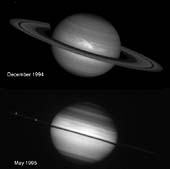|
COMETS EARTH JUPITER KUIPER BELT MARS MERCURY METEORITES NEPTUNE OORT CLOUD PLUTO SATURN SOLAR SYSTEM SPACE SUN URANUS VENUS ORDER PRINTS
PHOTO CATEGORIES SCIENCEVIEWS AMERICAN INDIAN AMPHIBIANS BIRDS BUGS FINE ART FOSSILS THE ISLANDS HISTORICAL PHOTOS MAMMALS OTHER PARKS PLANTS RELIGIOUS REPTILES SCIENCEVIEWS PRINTS
|
Related Document
Download Options
In one of nature's most dramatic examples of "now-you see-them, now-you-don't", NASA's Hubble Space Telescope captured Saturn on May 22, 1995 as the planet's magnificent ring system turned edge-on. This ring-plane crossing occurs approximately every 15 years when the Earth passes through Saturn's ring plane. For comparison, the top picture was taken by Hubble on December 1, 1994 and shows the rings in a more familiar configuration for Earth observers. The bottom picture was taken shortly before the ring plane crossing. The rings do not disappear completely because the edge of the rings reflects sunlight. The dark band across the middle of Saturn is the shadow of the rings cast on the planet (the Sun is almost 3 degrees above the ring plane.) The bright stripe directly above the ring shadow is caused by sunlight reflected off the rings onto Saturn's atmosphere. Two of Saturn's icy moons are visible as tiny starlike objects in or near the ring plane. They are, from left to right, Tethys (slightly above the ring plane) and Dione. This observation will be used to determine the time of ring-plane crossing and the thickness of the main rings and to search for as yet undiscovered satellites. Knowledge of the exact time of ring-plane crossing will lead to an improved determination of the rate at which Saturn "wobbles" about its axis (polar precession). Both pictures were taken with Hubble's Wide Field Planetary Camera 2. The top image was taken in visible light. Saturn's disk appears different in the bottom image because a narrowband filter (which only lets through light that is not absorbed by methane gas in Saturn's atmosphere) was used to reduce the bright glare of the planet. Though Saturn is approximately 900 million miles away, Hubble can see details as small as 450 miles across. Credits:
Top photo: Reta Beebe (New Mexico State University), D. Gilmore
L. Bergeron (ST ScI) and NASA.
Bottom photo: Amanda S. Bosh (Lowell Observatory), Andrew
S. Rivkin (Univ. of Arizona/LPL), the HST High Speed
Photometer Instrument Team (R.C. Bless, PI), and NASA.
|
